
The Wild Animal Sanctuary

Audio By Carbonatix
When word leaked out that Pat Craig was looking for a little piece of property, a spread that might accommodate up to 500 wild horses, the bad jokes started flying. What did Craig, founder and executive director of the world’s largest carnivore sanctuary, want with all those mustangs? Could it be…lunch?
“People heard we were interested in horses,” Craig says, “and everyone thought it was for the meat.”
Nobody was suggesting that Craig himself might be inclined to dine on horseflesh. But he does have some furry friends known for their meat-eating proclivities. The 1,200-acre Wild Animal Sanctuary in Keenesburg, forty miles northeast of Denver, is home to dozens of lions, tigers, leopards, jaguars, cheetahs, mountain lions, wolves, bears and other exotic animals, rescued from grimy roadside attractions, illicit breeding mills or other abusive conditions.
Add to that the exotics tucked away in a remote, 9,700-acre refuge in southeastern Colorado that the nonprofit established in 2018 for its ever-expanding clientele, as well as a modest bear-and-big-cat sanctuary in Texas that TWAS took over in 2020, and you’re talking about more than 750 hungry beasts – and annual care and feeding costs of approximately $14 million. According to the group’s annual report, the Keenesburg operation alone requires a staggering 2.75 million pounds of food a year.
Denver, make your New Year’s Resolution Count!
We’re $17,500 away from our End-of-Year campaign goal, with just a five days left! We’re ready to deliver — but we need the resources to do it right. If Westword matters to you, please contribute today to help us expand our current events coverage when it’s needed most.
But the sanctuary’s search for a horse property isn’t about trimming its grocery bill. It’s the centerpiece of a plan to establish yet another refuge, dedicated to Colorado’s wild horses – many of whom face a dubious future in long-term holding facilities after controversial government roundups on public lands. A few weeks ago TWAS announced that it had purchased a 22,450-acre former cattle ranch in northwest Colorado – enough hills and pastures, creeks and canyons, sagebrush and juniper to provide miles of free range for horses that have been deemed too indomitable, too old, or simply too unsuitable for adoption.
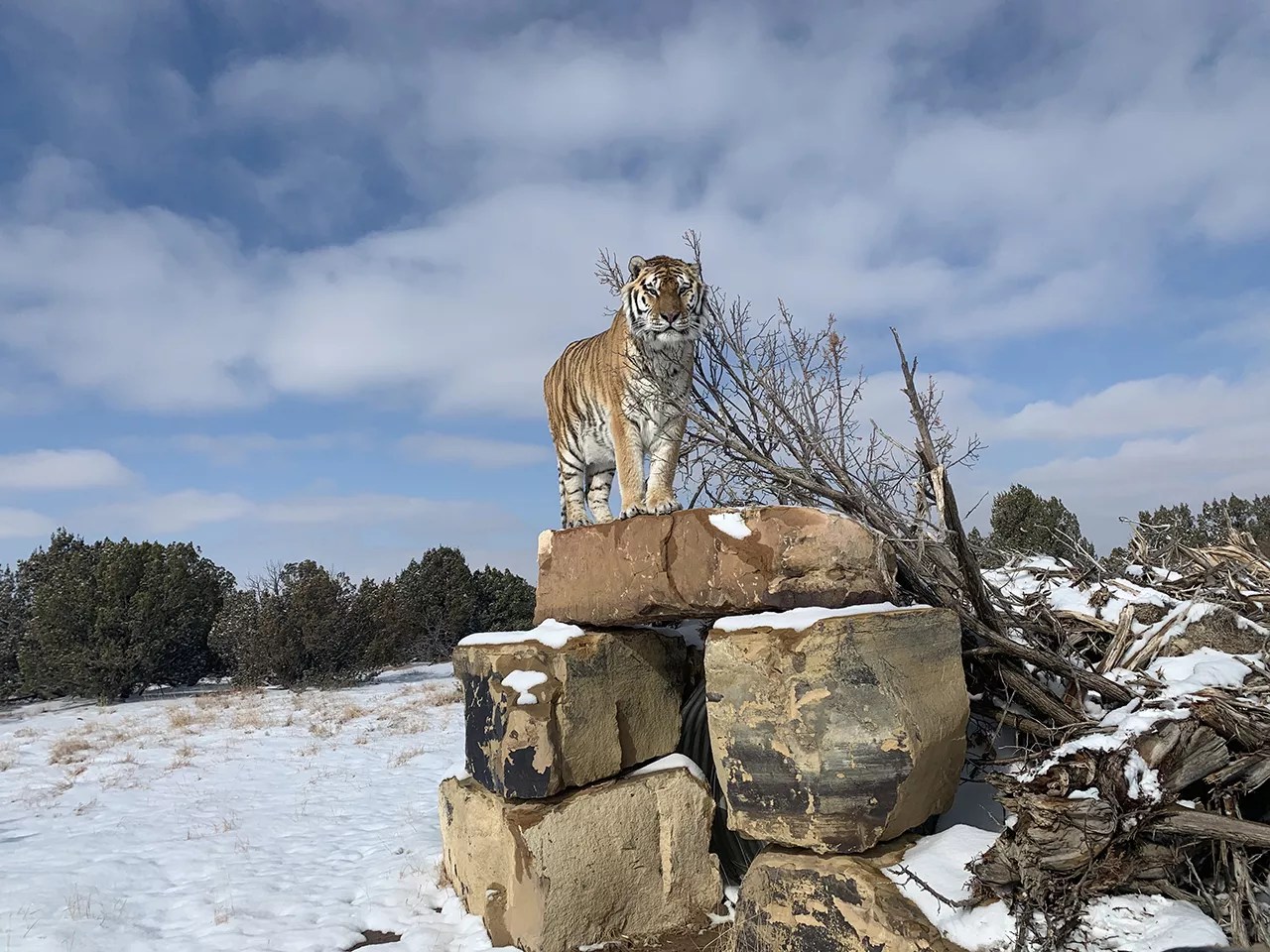
After the airing of Tiger King, Pat Craig’s group rescued 39 tigers from Joe Exotic’s failed zoo.
The Wild Animal Sanctuary
The bold move comes at a time when many animal welfare groups are still reeling from the aftershocks of the pandemic, which cut into donations, and the toxic emanations from the 2020 Netflix documentary series Tiger King, which introduced millions of Americans to Joe Exotic and the grotesque world of private zoos. But instead of cutting back, Craig is doubling down. In fact, there’s plenty of evidence to suggest that the collapse of Exotic’s skeevy little empire has been a boon to the sanctuary movement and The Wild Animal Sanctuary in particular, contributing to a sizable increase in its revenues and rescue efforts.
Now in his early sixties, Craig has been in the sanctuary business for more than forty years. Early on, many of those years were lean ones, and Craig scrambled constantly to meet expenses. But over the past decade or so, his organization has grown exponentially, from an audacious experiment on 240 acres struggling to raise its $1.5 million annual budget to a powerhouse with yearly revenues approaching $24 million and a land portfolio of 33,000 acres. The number of exotic animals it cares for has increased fivefold since 2008.
Despite the sanctuary’s impressive growth, taking on wild horses could prove to be a daunting challenge, even for someone as well-funded and savvy as Craig. There’s little consensus among mustang rescue groups about how to best manage the herds or extricate them from the seemingly endless loop of roundups and holding pens. Craig fully expects his Wild Horse Refuge will be closely scrutinized by those on various sides of the argument over whether nonprofits can do a better job of caring for the West’s iconic mustangs than the U.S. Bureau of Land Management.
“I guarantee you that there’s a lot of skepticism out there about us, but they’re all being very polite,” Craig says of the established rescue groups. “We’re stepping into new territory, with a lot of players. But we’ll be able to give hundreds of horses a good home. I don’t think anybody can bash that.”
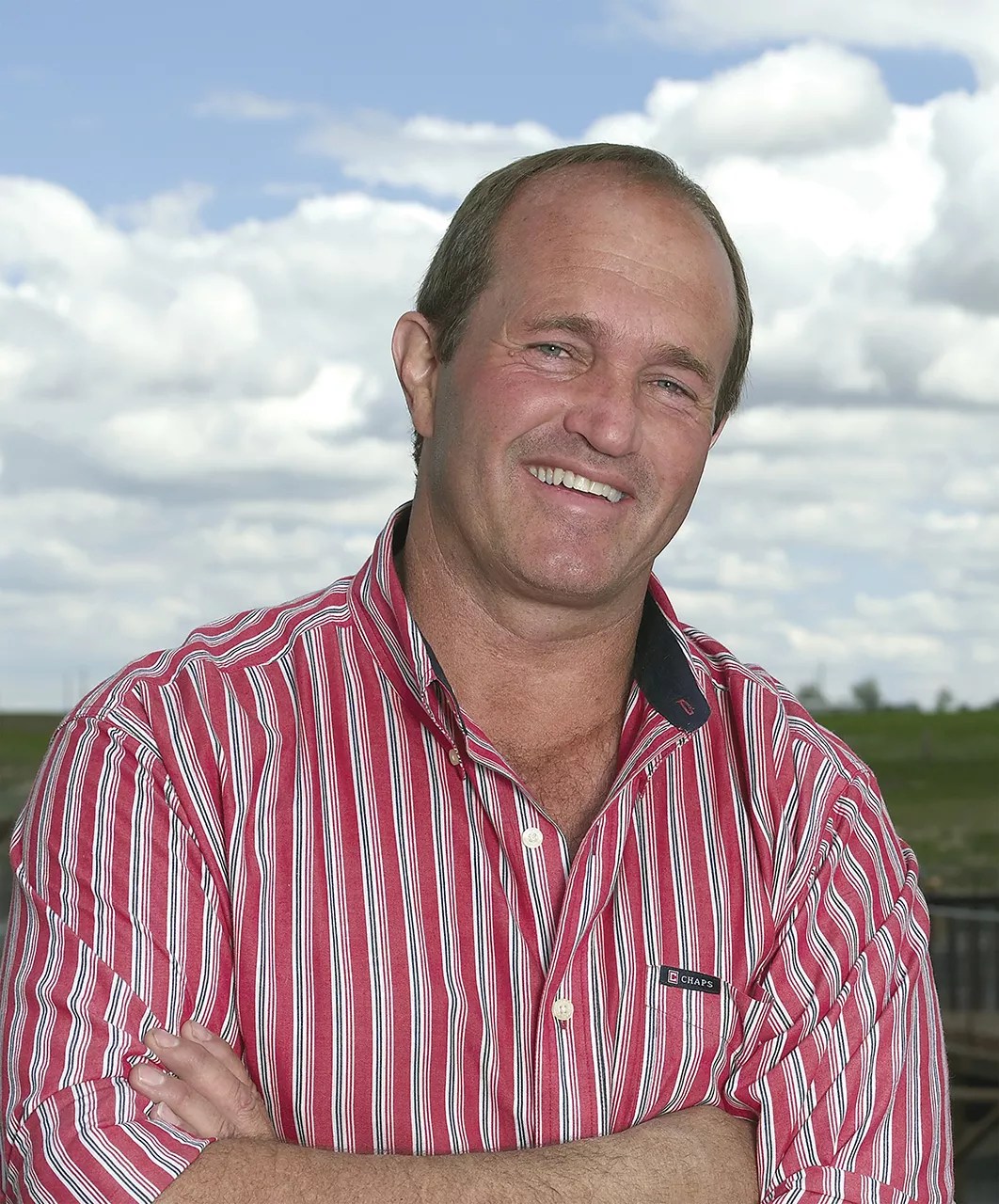
Pat Craig, founder of The Wild Animal Sanctuary in Keenesburg.
The Wild Animal Sanctuary
Growing up on a family farm north of Boulder, Pat Craig never gave much thought to what he now calls the “captive wildlife crisis.” But shortly after he finished high school, he visited a friend who worked at a South Carolina zoo. The friend introduced him to the “surplus” animals, the ones that languished in small cages and pens behind the scenes, never brought out to the larger, sunnier areas the public saw – the old, the cranky, the listless, most of them slated to be euthanized because of overbreeding and a lack of space.
Craig stared at the surplus. Bored, defeated, the surplus stared back. What he saw in their eyes haunted him.
He figured he might be able to adopt a few of these undesirables. At nineteen, he obtained state and federal licenses to operate a small “rescue facility” for carnivores on the family farm. He was soon deluged with offers from zoos, seeking to turn over their hardest-to-place big cats.
He started small, with a single, sickly jaguar cub, but within a few years he had more beasts than the farm could handle. He moved to leased land near Lyons, and then, in the 1990s, to Keenesburg – at the time, a largely undeveloped area of wheat farms and cheap land. As his efforts expanded, he found innovative ways to feed and shelter his charges without going broke.
He acquired refrigerated trucks and worked with major food suppliers to take donations of excess perishables, including cases of frozen turkeys. (TWAS now has three full-time truck drivers and arrangements with sixty food outlets around the Front Range.) He salvaged concrete conduits left over from highway projects for dens and bunkers, providing shade and shelter for the various fenced but airy habitats, which stretch for acres rather than mere feet. He recruited volunteers who were not only willing, but eager to muck out big-cat dens and serve food.
Craig also pushed for new ways for visitors to interact with the place. Twenty years ago, TWAS began erecting an elevated walkway that would allow people to safely stroll 35 feet above the habitats, observing the wildlife below – without, Craig insists, inflicting stress on the animals that comes from the in-your-face gawking in a typical zoo. The “Mile Into the Wild” walkway now spans a total of 1.5 miles, which the group says is a world record for such a structure.
“After the walkway was built, people from the industry started coming here to see what we were doing,” Craig says. “They all said they loved it. We showed them how to do it. But it takes a lot of time and,money, and so far nobody has done anything like it.”
The walkway is one example of how TWAS has tried to differentiate itself from other players in the “industry.” It also reflects Craig’s beliefs about where the sanctuary movement should be directing its energy. His sanctuary no longer takes many surplus animals, and Craig says the major zoos are managing their populations much better now than they were in the 1980s. Most of his current charges are rescues from decrepit private zoos, black-market breeders and hoarders who keep giant beasts chained in tiny trailers or worse. Thousands of wild animals live in captivity in North America – and only a small percentage of them are in publicly funded zoos. (The World Wildlife Fund estimates that there are 5,000 captive tigers in the United States, more than can be found in the wild.) His primary mission, Craig insists, is to stop captive breeding and abuse, rehabilitate damaged animals, and provide them a pleasant home for the rest of their days.
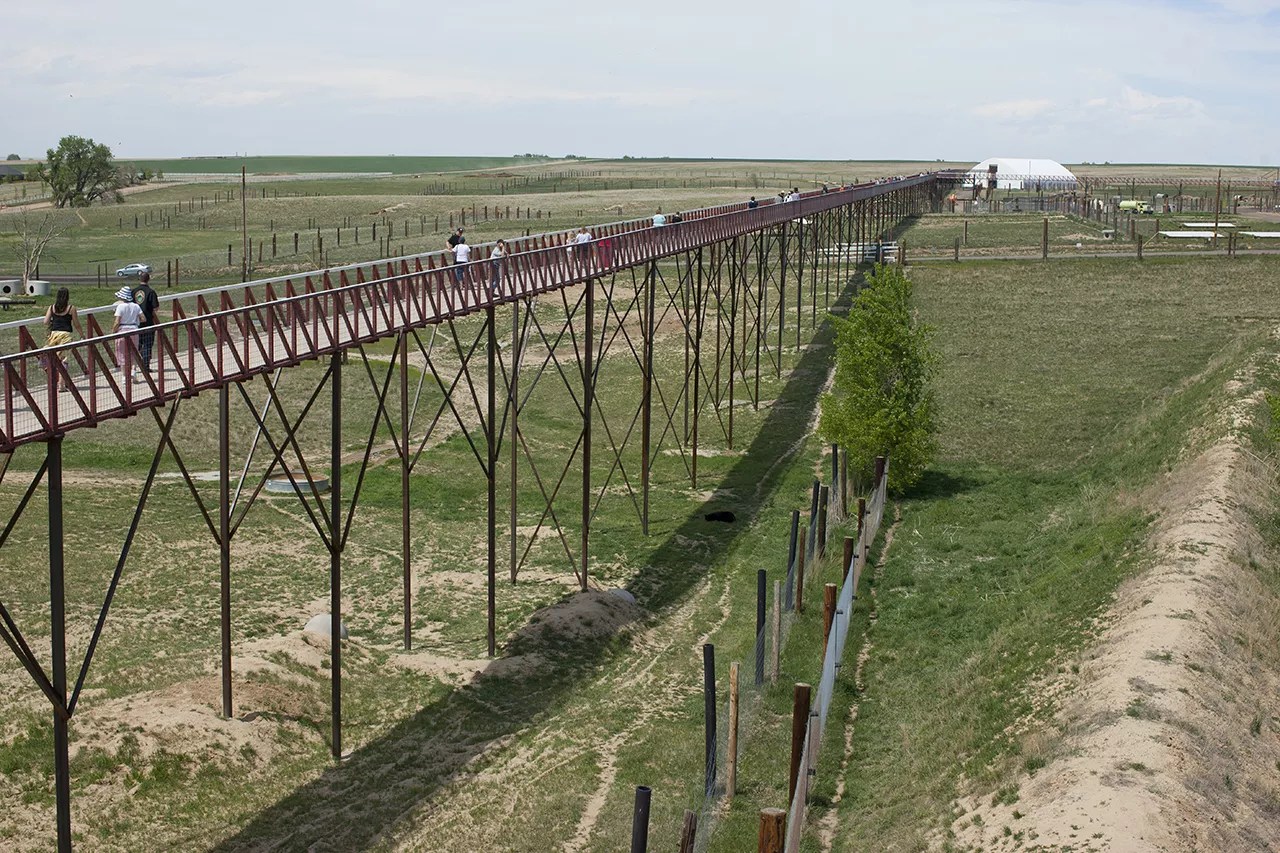
An elevated walkway at the Keenesburg site allows visitors to observe wildlife in uncrowded habitats.
The Wild Animal Sanctuary
Initially reluctant to open his gates to visitors, Craig was eventually convinced that getting the public involved would provide badly needed revenue and educate people about the captive wildlife problem. He insisted on signs explaining that the animals were not there to perform for tourists; no dancing bears, no adorable tiger cubs to pet. But as the crowds surged, he began to regret his decision.
“There was this big misnomer that we were another zoo,” he recalls. “We started getting up to 200,000 visitors a year, and at least half of them thought it was for entertainment. They were leaving trash everywhere. They were writing graffiti. They didn’t care. They didn’t want to learn. It was crazy. We tried so many different ways to fix that.”
The fix that worked was hiking the admission fee by more than 300 percent. It now costs fifty bucks for an adult to visit the sanctuary at Keenesburg, thirty bucks for a child. Craig says the move “totally transformed our organization.” It boosted revenues, weeded out the zoo crowd, and encouraged visitors to spend longer at the facility, learning about the plight of captive wildlife (as well as visiting the place’s restaurants and souvenir shops). Although the sanctuary’s core demographic is well-educated women above the age of forty, he says the sanctuary still has low-income visitors as well: “When we said it was fifty dollars, the ones who cared kept coming.”
The new policy didn’t cause much upheaval in the surrounding Keenesburg-Hudson-Roggen area, where Craig is widely regarded as a good neighbor, even if he does have a lot of cats. Longtime resident Cindy Baumgartner, Keenesburg’s mayor pro-tem, says TWAS has been a welcome addition to the local economy and supportive of local businesses. “Pat’s been generous in donating his time and his resources,” she says. “Are we thankful to have him? Yes, we are.”
The successful price boost encouraged Craig and his team to think even bigger about what they could accomplish and what kind of support they could expect from donors. In recent years, TWAS has rescued hundreds of animals from dire situations all over the globe, including tigers from Argentina, lions from Mexico, a wallaby from Lebanon, bears from South Korea, servals from Guam, coyotes from Iowa, wolves from Louisiana, spotted hyenas from California, and a bunch of kangaroos and miniature pigs from Colorado. Although the sanctuary bought up adjoining parcels of land when available, it was increasingly landlocked and running out of space.
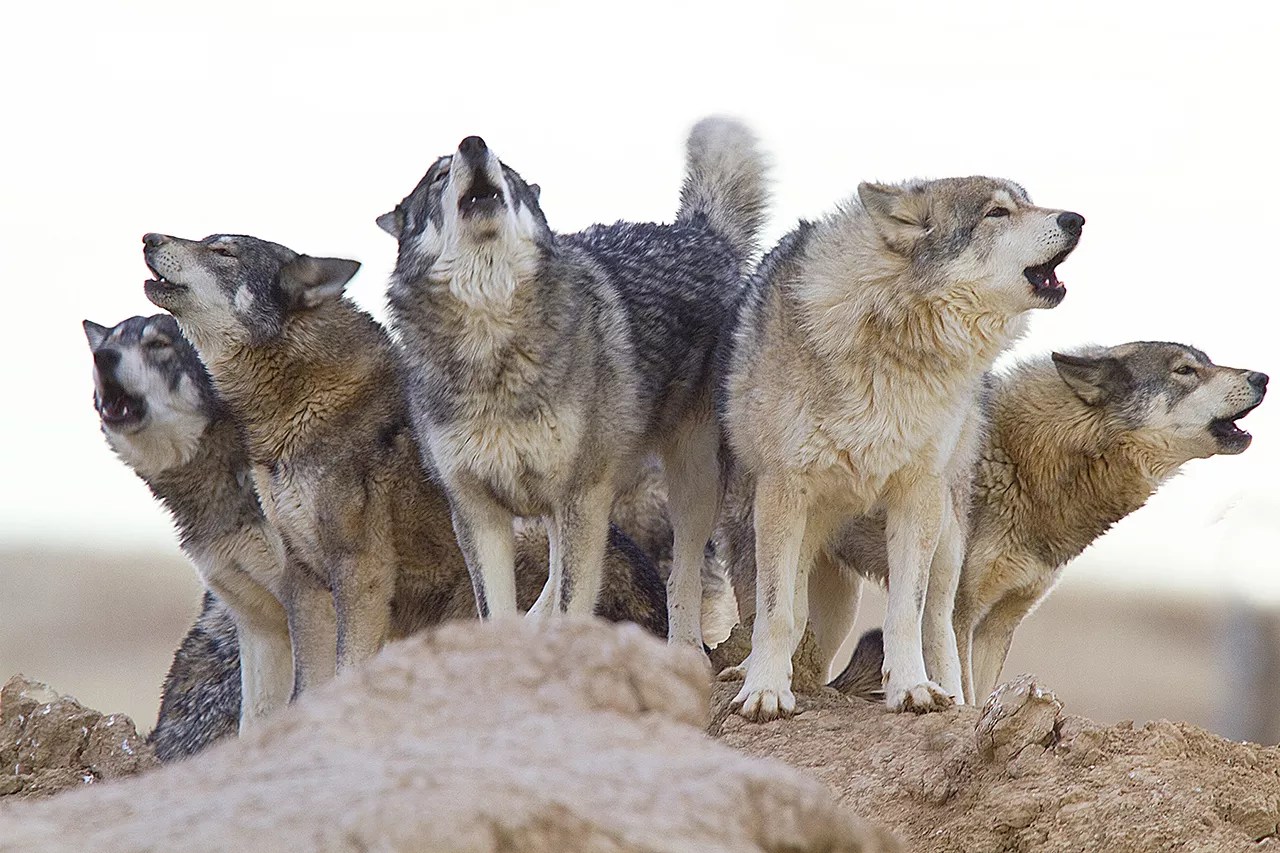
Wolves have found sanctuary in Keenseburg.
The Wild Animal Sanctuary
Five years ago the organization purchased a rugged stretch of hill-and-canyon country in southeast Colorado near Springfield, almost eight times the size of the Keenesburg spread, to handle its overflow. The area has been fenced into separate habitats to keep the peace and isn’t open to the public, though VIP tours are available to generous donors known as “founders.” TWAS invited its supporters to contribute an acre of land each, at a cost of $777, to help raise the $7 million purchase price. With the aid of a conservation easement, Craig says, the group was able to pay off the place in less than four years.
In 2020, TWAS also assumed control of a 41-acre sanctuary in Boyd, Texas, after its founder contacted the group, asking for help. “The animals were well cared for,” Craig says. “We left it its own entity but taught them how to fundraise.”
That deal was closed right around the time Tiger King had its moment. Joseph Maldonado-Passage, alias Joe Exotic, had been a thorn in the paw of the sanctuary movement long before the Netflix project turned him into the marquee scumbag of reality-TV superstars. His Greater Wynnewood Exotic Animal Park was notorious for its cub-petting events and miserable working conditions for man and beast. Exotic was ultimately convicted on seventeen federal charges of crimes against wildlife, but it was his involvement in a failed murder-for-hire plot that grabbed the headlines and accounted for the bulk of his 21-year prison sentence. No doubt inspired by Eugene Debs’s 1920 campaign, Exotic recently declared that he will run for president from his cell in 2024.
Prior to shopping for a hit man, Exotic had lashed out at his critics in a series of online video tirades. One of his targets was Craig, whom he accused of hypocrisy for sneering at a public that wants to pet exotic animals while often getting touchy-feely with them himself. He dissed the elevated walkway as a safety hazard, accused Craig of not knowing how to handle big cats, and insinuated that the operation was more about making money than saving animals. (Craig, who resisted taking any kind of salary until the organization was on firm ground, now draws a salary of $250,000 a year; he notes that the board of directors of TWAS sets his compensation based on comparability data for similarly situated nonprofits.)
The rabid popularity of Tiger King left some animal activists concerned that it would encourage Exotic wannabes, but Craig saw Exotic’s star turn as a plus. Not only did TWAS end up rescuing dozens of distressed big cats, bears, wolves and other animals from Greater Wynnewood and related operations, but revulsion over private zoos has never been stronger.
“I was one of the first to say that I didn’t care if people thought it was funny or what,” Craig says. “What happened was millions [of viewers] learned that there are people breeding the crap out of lions and tigers, and a lot of the bad actors have seen that the Department of Justice is now much more willing to go after them. They know they have to get out of this and do something else.”
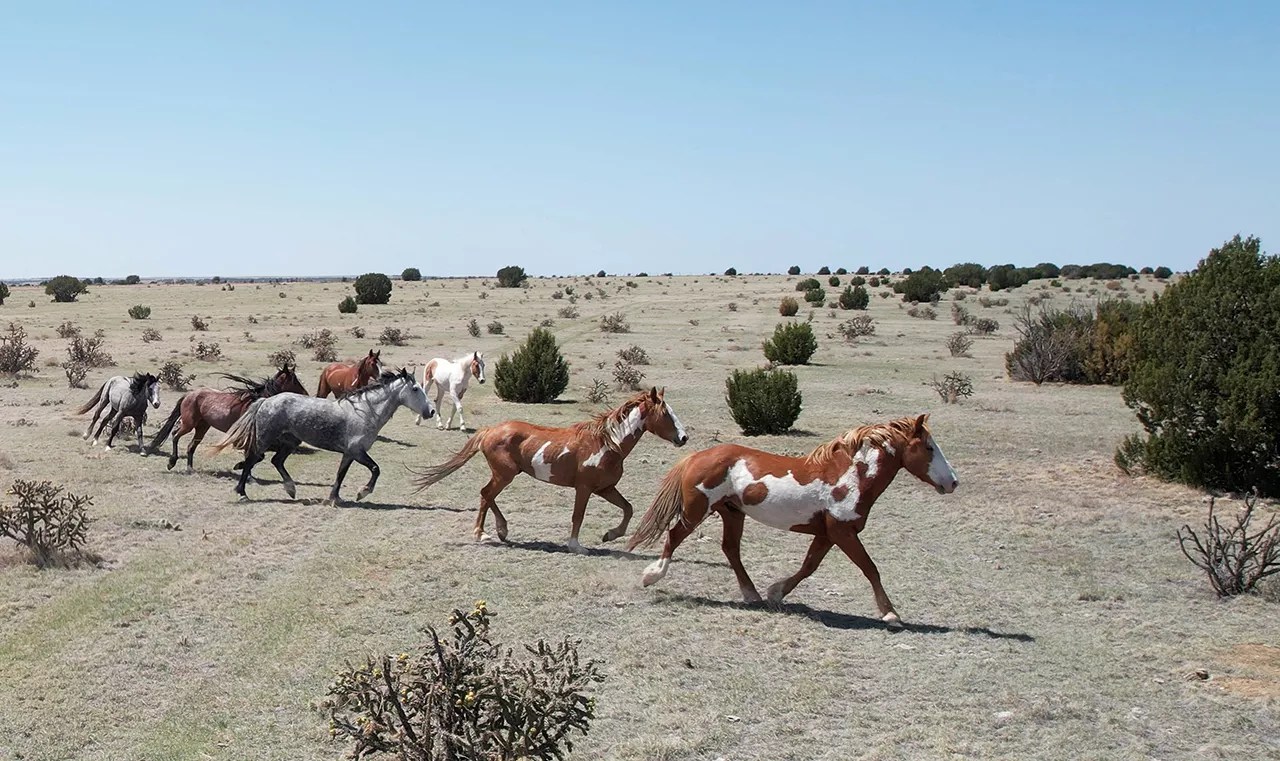
Pat Craig plans to adopt up to 500 wild horses; dozens have already arrived at a refuge in southeast Colorado.
The Wild Animal Sanctuary
In 1971, Congress passed a law charging the Secretary of the Interior with the job of protecting America’s wild, free-roaming horses and burros “from capture, branding, harassment or death” – and managing the herds in an ecologically sound way. Since that time, the lead agency designated to fulfill that mandate, the Bureau of Land Management, has removed around 4,000 so-called “excess” wild horses from public lands in Colorado. More than 1,500 of those removals have occurred in the last two years, leaving an estimated 1,800 wild horses in the state, scattered across four herd-management areas on the Western Slope.
Given the particularly brutal recent winter in northwest Colorado, the actual surviving herd numbers may be well below the estimate. But BLM officials maintain that the remaining herds still need substantial thinning to reach population levels that the management areas, which comprise more than 400,000 acres, can reasonably support. Without drastic interventions, they say, the herds will soon exhaust the available forage, do irreparable harm to the ecosystem, and face death from starvation and thirst.
Mustang advocacy groups tend to see the situation differently. They accuse the BLM of caving to pressure from ranching and energy interests, which expect ready access to public lands under the federal government’s “multiple-use” management policies. They contend that removals could be reduced if more resources were invested in safe, long-term contraception treatments (and if the horses weren’t in such overheated competition with livestock). And they have been sharply critical of BLM’s approach to its mission, from the use of helicopters in its roundups to the failures and scandals of its wild horse adoption program.
There are now more than 60,000 wild horses and burros in long-term holding facilities around the country, costing taxpayers $80 million a year. That’s close to double the number still left in the wild. The BLM has pushed its successful adoption rate up to 50 percent and claims that its remaining captives are “cared for on open pastures for the rest of their lives.” But the advocacy groups say that too many of the unadopted animals are left to languish, sicken – an equine flu outbreak at the Cañon City facility was linked to 146 deaths last year – or be euthanized. Even the cash incentives the BLM offers to prospective adopters, they say, can encourage unscrupulous profiteers intent on selling adopted horses to slaughterhouses.
“There simply isn’t the capacity to support the number of horses that are being removed,” says Scott Wilson, a wildlife photographer and Colorado spokesman for the American Wild Horse Campaign. “It’s a broken system.”
“There simply isn’t the capacity to support the number of horses that are being removed. It’s a broken system.”
Last year, after reports emerged about the horse deaths in Cañon City, Governor Jared Polis urged the BLM to cancel a massive roundup of the Piceance-East Douglas herd and explore “more humane” alternatives. His pleas were unsuccessful, but Polis also reached out to Pat Craig, wondering if TWAS could take in a few horses that weren’t good candidates for adoption. The group soon relocated close to three dozen wild horses to its refuge near Springfield, a move that eventually led to the purchase of the horse property on the other side of the state, less than an hour’s drive from the Sand Wash Basin herd management area.
The Wild Horse Refuge will soon be home to the mustangs from Springfield, as well as other graduates of BLM roundups. The place will not be open to the public. Craig is hopeful that the property can accommodate up to 500 wild horses, which may seem wildly optimistic, given that the government calculates that the entire Sand Wash Basin area, nearly eight times larger than the refuge, shouldn’t have more than 160 to 360 horses. A thorough environmental assessment is still pending, but Craig anticipates that the number of horses his group can support will be bolstered by the lack of competition with livestock – and the fact that TWAS won’t have to contribute much more than routine veterinary care to their upkeep.
“These horses are just as wild as a wild tiger,” he says. “They know how to dig down to find water, how to survive the deepest snow.”
Stella Trueblood, a volunteer with the Sand Wash Advocate Team (SWAT), is involved in monitoring the Sand Wash herd and administering fertility control treatments. She says the 400 or so horses that remain in the area after a 2021 roundup are “really struggling” after months of subzero temperatures and exceptionally heavy snow. She praises Craig for his willingness to take on the less adoptable captures.
“Anyone who’s a true advocate sees the value of what he’s doing,” Trueblood says. “We were contacted by the BLM about three old horses with injuries that they didn’t consider to be good adoption candidates. I contacted Pat, and he took them without question.”
The AWHC’s Wilson agrees that the Wild Horse Refuge and smaller, established havens have a vital role to play in salvaging the West’s “excess” mustangs. “The effort they’re making is absolutely welcome and necessary,” he says.
Still, Wilson notes, the larger problem won’t be solved by any single agency or nonprofit. He believes it will take various stakeholders working together to shift resources away from the roundups and into a more cost-effective, sustainable investment in fertility control measures: “We want to look back on the range and fix the problem right there.”
Craig is the first to admit that a sanctuary is not an open range or a wilderness. What he provides is an artificial home for animals that have been torn from their place in the natural world and then deemed to be superfluous. But in virtually every case, it’s a measurably better home than where they’ve been. Last month Craig was in Puerto Rico, laying the groundwork for a possible transfer of hundreds of animals to Colorado from the island’s hurricane-ravaged (and now defunct) zoo.
The logistics of such projects are mind-boggling, but Craig keeps finding ways to make them work. Last year he managed to spirit 22 Asiatic black bears out of horrific conditions in South Korea. It was part of a larger joint effort with a coalition of animal welfare groups to end the breeding of hundreds of bears in that country just so that their bile can be harvested for traditional herbal medicines. Craig couldn’t take them all, but the resulting publicity, condemnations and shaming put pressure on the South Korean government to devise its own sanctuaries for the survivors.
“It’s not about the limelight,” Craig says. “It’s not our goal to have the most animals or the most land. It’s about making a difference.”